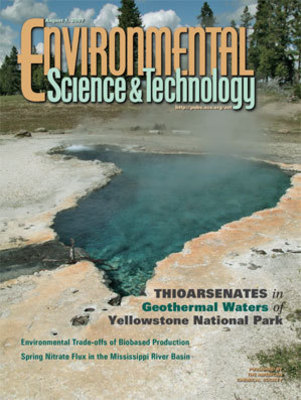| Planer-Friedrich, B; London, J; McCleskey, RB; Nordstrom, DK; Wallschläger, D: Thioarsenates in geothermal waters of Yellowstone National Park: determination, preservation, and geochemical role, Environmental Science Technology, 41(15), 5245-5251 (2007) | |
| Abstract:
Mono-, di-, tri-, and tetrathioarsenate, as well as methylated arsenic oxy- and thioanions, were determined besides arsenite and arsenate in geothermal waters of Yellowstone National Park using anion-exchange chromatography inductively coupled plasma mass spectrometry. Retention time match with synthetic standards, measured S:As ratios, and molecular electrospray mass spectra support the identification. Acidification was unsuitable for arsenic species preservation in sulfidic waters, with HCl addition causing loss of total dissolved arsenic, presumably by precipitation of arsenic-sulfides. Flash-freezing is preferred for the preservation of arsenic species for several weeks. After thawing, samples must be analyzed immediately. Thioarsenates occurred over a pH range of 2.1 to 9.3 in the geothermal waters. They clearly predominated under alkaline conditions (up to 83% of total arsenic), but monothioarsenate also was detected in acidic waters (up to 34%). Kinetic studies along a drainage channel showed the importance of thioarsenates for the fate of arsenic discharged from the sulfidic hot spring. The observed arsenic speciation changes suggest three separate reactions: the transformation of trithioarsenate to arsenite (major initial reaction), the stepwise ligand exchange from tri- via di- and monothioarsenate to arsenate (minor reaction), and the oxidation of arsenite to arsenate, which only becomes quantitatively important after thioarsenates have disappeared. |


